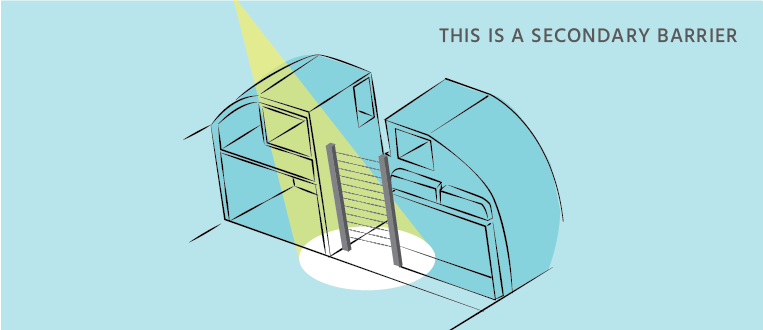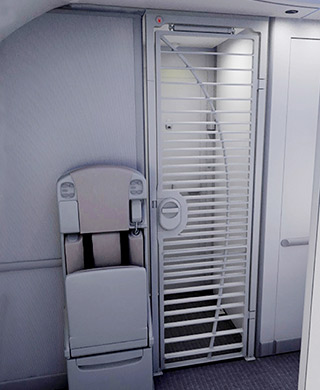Flight Deck Barriers Are Critical for Security
The downing of four commercial airplanes and loss of nearly 3,000 lives on 9/11 was due, in part, to inadequate protection of the aircraft flight deck. Hardened flight deck doors have improved security on passenger aircraft, but a secondary barrier would be an added layer of protection. Meanwhile, a glaring security gap remains with all-cargo operations, which have no such requirements for intrusion-resistant doors.
Secondary Barriers on Passenger Aircraft
Since the terrorist attacks on September 11, 2001, ALPA has advocated for the mandatory installation of a lightweight security device known as a “secondary barrier” on commercial aircraft. These devices have proven effective in creating a physical barricade to prevent hostile individuals from reaching the flight deck any time the cockpit door is open during flight. Secondary barriers ensure the flight deck remains secure at all times.

Background
Shortly after 9/11, Congress and the Federal Aviation Administration (FAA) required the installation of hardened flight deck doors on most commercial airline aircraft as one of many new layers of security. The hardened flight deck doors are an important improvement to security, but they are not a complete solution to preventing unauthorized individuals from entering the flight deck.

The flight deck door must be opened during flight to provide for pilots’ biological needs and for operational requirements related to safety. Americans remain vulnerable to terrorist attacks; there have been at least 52 hijacking attempts around the world since 9/11. The U.S. government has repeatedly and recently confirmed that aviation is still a target of radical terrorists and the threat of hijackings is real.
Since 2003, two major airlines have voluntarily installed a lightweight, inexpensive wire mesh, called a flight deck secondary barrier, on hundreds of their aircraft, which is permanently mounted between the flight deck door and the cabin. Boeing and Airbus offer the secondary barrier as equipment on new aircraft; installation of retrofitted secondary barriers on aircraft already in the fleet represents a minimal cost as they can be added for approximately $5,000 per aircraft or less. A consensus-based secondary barrier technical standard exists, as does a report from the Aviation Rulemaking Advisory Committee that defines a consensus-based path forward.
“If you know anything about terrorists, they look for weaknesses. This is something that nobody is taking the responsibility for—to do what’s right for the safety and security of Americans . . . There is a simple solution to at least take that threat out of the way.” These words by Ellen Saracini ring just as true today as they did in September 2013, when both the U.S. House of Representatives and the Senate introduced the Saracini Aviation Safety Act of 2013. Named after Saracini’s late husband, Capt. Victor Saracini, the pilot of United Flight 175, which was hijacked by terrorists and flown into the World Trade Center on September 11, 2001, the bill called for the installation of secondary flight deck barriers on all airliners. Read more about Ellen Saracini’s work with ALPA to secure the flight deck.
ALPA Recommends
- The administration must promulgate an immediate final rule for installation of secondary barriers for all newly manufactured passenger aircraft, as required by law.
- Congress should pass H.R./S. 911, the Saracini Enhanced Aviation Safety Act, to require that all passenger aircraft are equipped with secondary barriers.
Primary Barriers on All-Cargo Aircraft
A glaring security gap in all-cargo operations is the lack of an intrusion-resistant cockpit door (IRCD). There is a common misconception that all-cargo operations do not carry passengers. However, non-flightcrew members, known as supernumeraries, can be onboard to support transported animals (e.g., horses) and have unfettered access to the flight deck. The lack of an IRCD on all-cargo aircraft creates a vulnerability if there is an attempt to take over the aircraft or an attack on the pilots or flight deck.
Background
Anti-hijacking procedures referred to as the “common strategy” were created in the early 1970s by the FBI, the FAA, airlines, and ALPA, and revised after 9/11. The common strategy is intended to address all types of security threats encountered during passenger and all-cargo operations and is based on the premise that there will be aircraft equipped with intrusion-resistant cockpit doors, properly trained people, and procedures for handling direct security incidents and threats.
This approach is sound and provides for needed layers of security, if all three measures are available. Unfortunately, for cargo aircraft not equipped with these intrusion-resistant cockpit doors, the tactics, techniques, and procedures designed to provide crews with sufficient time to react to threats to the cockpit are meaningless. In addition, all-cargo flight crews are not required to be trained in the common strategy to the same degree as passenger crews, defeating the purpose of the common strategy, which is intended to be used by crews during line operations. If the crew is not properly trained and required to utilize the strategy, there is no way it can be implemented effectively.
All-cargo operations face security threats that aren’t always immediately apparent. For example, all-cargo aircraft often carry live animals, and animal handlers accompany them on the flight. In many circumstances, these handlers carry tranquilizing drugs for use on the animals during flight. Most of the animal handlers are not airline employees, and many are foreign nationals, which limits the ability to conduct a criminal history records check on these individuals. This creates a significant risk to the cargo flight and crew when they are not protected from these potential threats by a cockpit door. Any individual traveling on an all-cargo flight should be subject to the same level of security vetting and screening as flightcrew members.
ALPA Recommends
- The Federal Aviation Administration (FAA) should require all-cargo aircraft to be equipped with hardened IRCD and should regulate the carriage of supernumerary passengers on all-cargo aircraft. This includes prohibiting transportation of any persons on non-IRCD aircraft for both 14 CFR Part 121 and 129 all-cargo operations that do not meet definitions established in FAR 121.547 allowing flight deck access.
- The FAA should mandate that all flights with animal handlers must be conducted on IRCD-equipped aircraft, with the animal handlers outside the flight deck behind an installed IRCD.
- Congress should pass the Cargo Flight Deck Security Act to require an IRCD on all-cargo aircraft.

